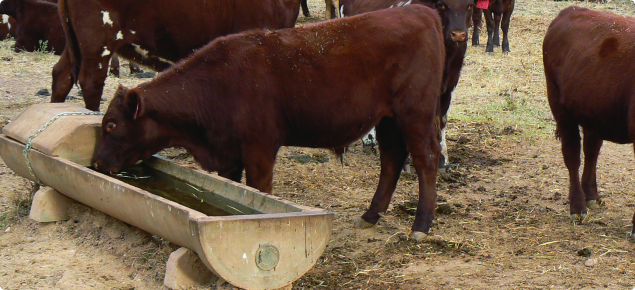Landholders can protect and improve water quality for stock during summer by:
- shading water sources
- monitoring salinity and pH levels
- cleaning troughs frequently
- preventing algal blooms and water contamination
- maintaining groundcover around dams
- skimming dam surfaces after rainfall and strong wind events
- taking steps to reduce evaporation.
Poor-quality water can reduce animal production, impair fertility and lactation and, in extreme cases, cause animal losses as stock drink less than they need or stop drinking altogether.
Salinity, acidity, algal growth, pollution and toxic elements all affect the suitability of water for stock.
How much water do animals need?
Water demand changes according to season, age and lactation status of animals.
Water demand also increases when livestock move from succulent green feed to dry feed and supplements and when water salt content is high.
Providing shade and shelter to reduce heat stress will reduce water demand.
For specific requirements for various types of livestock see our Calculating livestock water requirements page.
Salinity affects drinking
Livestock can consume 50–80% more water if it contains more than 2000 parts per million (ppm) total of dissolved salts, partly because of taste and partly to dilute or flush the salts from their systems.
Eventually stock will refuse to drink highly saline water.
Surface waters such as dams generally have lower salt levels compared with underground or bore water.
However, monitor all water sources to ensure levels are not toxic to livestock (see Table 1).
| Livestock | No adverse effects on animals expected | Animals may have initial reluctance to drink or there may be some scouring, but stock should adapt without loss of production. | Loss of production and decline in animal condition and health would be expected. Stock may tolerate these levels for short periods if introduced gradually. |
|---|---|---|---|
| Beef cattle | 0-4000 | 4000-5000 | 5000-10 000 |
| Dairy cattle | 0-2500 | 2500-4000 | 4000-7000 |
| Dairy cattle milking | 3500 | ||
| Sheep, | 0-4000 | 4000-10 000 | 10 000 - 13 000 (b) |
| Lambs, weaners, breeders | 6000 | ||
| Horse | 0-4000 | 4000-6000 | 6000-7000 |
| Pigs | 0-2000 | 3000 | 4000 |
| Poultry | 0-2000 | 2000-3000 | 3000-4000 |
(a) Convert to total dissolved solids (TDS; ppm or mg/L) by multiplying conductivity values (millisiemens/metre (mS/m)) by 5.5. (b) Sheep on lush green feed may tolerate up to 2360 mS/m (13 000 mg/L TDS) without loss of condition or production. Reference: Modified ANZECC and ARMCANZ (2000), adapted from ANZECC (1992).
Weather conditions, animal age and condition, distance to feed and water, pasture composition, use of supplementary feed and type of dissolved salts affect how stock tolerate salinity.
For example pregnant, lactating or young animals are less tolerant of salty water than dry, mature animals.
Stock weakened by drought conditions can also have a reduced tolerance to high salt levels.
Adapting to saline water
Introduce saline water slowly as sudden changes can cause stock to refuse the new water or they could drink it but become ill or die. Mix fresh and saline water for a few days to help stock adapt.
Salt levels can become toxic due to evaporation of salty water in troughs.
It is essential to clean and flush troughs regularly during summer and provide shade where possible to prevent animal losses.
Acidity or alkalinity
Water pH below 6.5 or above 8.5 can upset stock digestion.
This can cause animals to reject water, which can depress their appetite and reduce production. Deaths have occurred even when an adequate supply of water is available.
Use alum to correct a high pH or add lime to low pH water.
Algal blooms
Algae can contaminate surface water and cause:
- a foul taste
- odour
- stagnation from reduced oxygen levels
- possible stock poisoning.
Warm weather and low surface flows together with high nutrient levels from decaying organic matter, phosphates, industrial waste or sewerage pollution, encourage excessive algae growth in dams and slow-moving streams.
This can result in masses of algae called blooms.
Many varieties of algae can cause blooms that range in colour from green to blue, red, brown, dark green or black. These can persist for several weeks to months.
Algal blooms in farm dams can be difficult to remove but cool, windy weather or increased water flow can reduce algal growth. Not all blooms are poisonous but blue-green algae can pose a risk to humans and stock.
It is recommended landholders treat blooms as toxic until after testing. For more information see our Toxic algal blooms page.
Polluted water
Manure and dried vegetation can blow or wash into water storages making water unpalatable to stock.
Bacteria and algae grow rapidly on this material, which reduces oxygen levels and turns the water black and putrid. A thick scum around the water’s edge can develop making stock access difficult.
Although generally not poisonous, contaminated water can be harmful to young or weak stock and can reduce animal production.
Maintain groundcover around dams or build a sediment trap using straw bales, netting or corrugated iron where groundcover has been reduced.
Skimming debris from the water’s surface within 48 hours of rainfall or a strong wind event can reduce contamination.
Reticulating dam water into troughs can reduce pugging and bogging of dams, but the reticulation system needs to be reliable and able to meet peak animal demands.
Pumped water has higher oxygen levels, which can reduce contaminant levels. Aquatic plants also help to re-oxygenate dams, but be aware of declared plants and weeds.
It is critical to the condition and health of your stock to monitor water quality and quantity during summer. Failure to do so can lead to illness and possible death from toxic pollutants.
For more information see the Water quality for livestock page.

